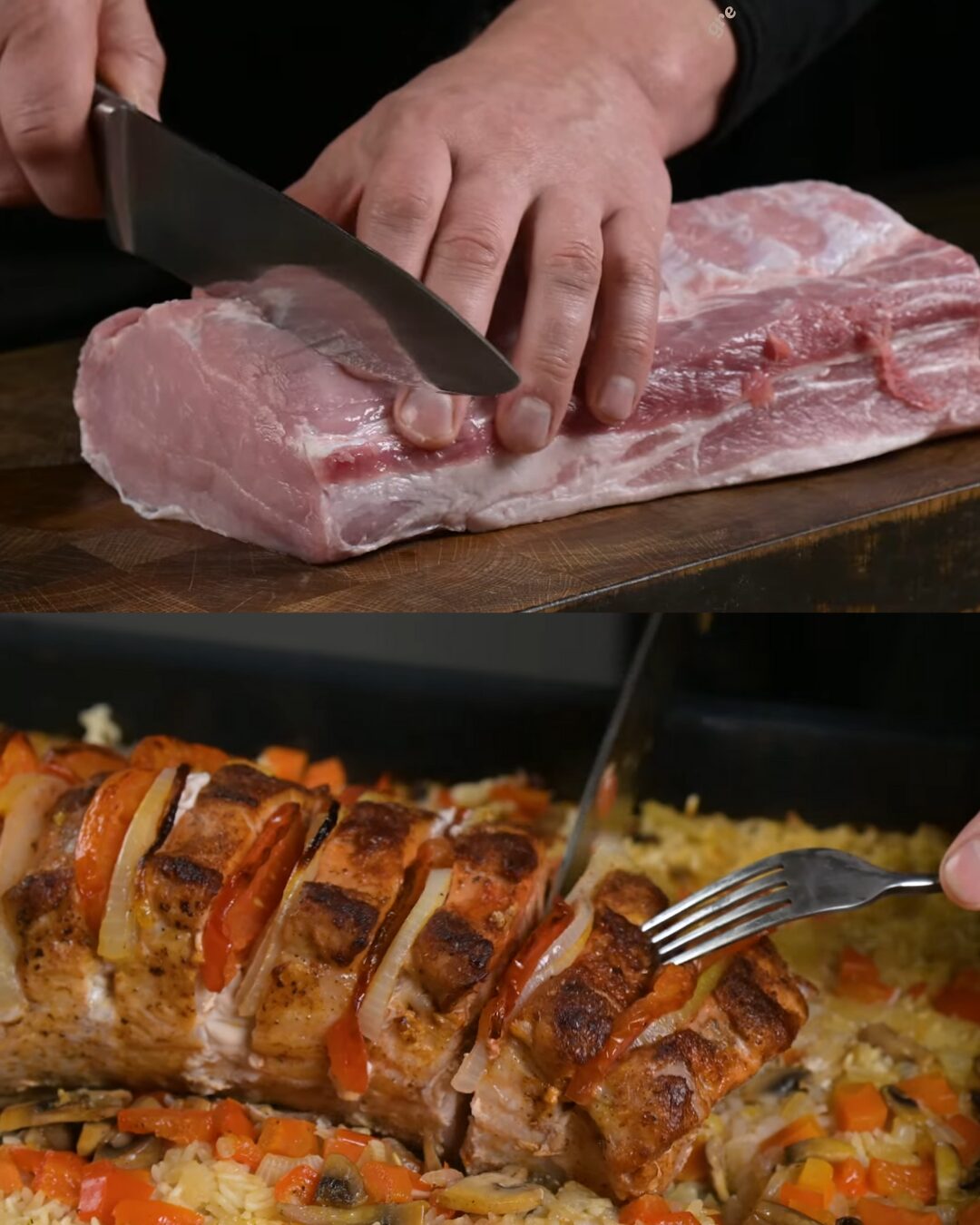If you’re looking for a hearty and satisfying dish that delivers maximum flavor with minimal fuss, this Baked Stuffed Pork Roast with Rice and Vegetables is the ultimate crowd-pleaser. This rustic one-pan wonder combines succulent pork marinated and pan-seared to golden perfection, stuffed with aromatic onion and juicy tomato, then baked over a savory bed of rice, mushrooms, carrots, bell peppers, and broth. Each element soaks up flavor from the meat and herbs, creating a balanced and deeply comforting dish.
Whether you’re cooking for a family dinner, a holiday celebration, or meal prepping for the week, this recipe offers a wholesome, protein-packed solution with simple ingredients and bold results.
Cooking Time
Prep Time: 30 minutes
Cook Time: 1 hour 30 minutes
Total Time: 2 hours
Servings: 6-8
Ingredients
For the Pork and Marinade:
-
2 kg pork shoulder or loin
-
Salt (to taste)
-
Black pepper (to taste)
-
1 tsp paprika
-
2 tbsp olive oil
For Searing and Flavor Base:
-
40 g butter
-
3–4 garlic cloves, crushed and finely chopped
-
1 large onion, chopped
-
1 large carrot, chopped
-
150 g mushrooms, sliced
-
1 bell pepper, chopped
-
Additional salt and black pepper (to taste)
For Stuffing:
-
1 onion, cut into half rings
-
2 medium tomatoes, sliced
For the Rice Layer:
-
450 g uncooked rice
-
500 ml chicken stock
-
500 ml water
-
Chopped herbs (parsley, dill, thyme – to taste)
Step-by-Step Cooking Directions
Step 1: Prepare the Pork
Make several deep cuts into the pork without cutting all the way through—creating pockets for seasoning and stuffing. Rub the entire surface of the meat with salt, black pepper, paprika, and olive oil, ensuring it penetrates the cuts.
Step 2: Sear the Pork
Heat 40 g of butter in a large skillet. Add the pork and sear on all sides over medium-high heat until golden brown, approximately 2–3 minutes per side. Remove and set aside.
Step 3: Sauté Aromatics and Vegetables
In the same skillet, add crushed garlic and cook for 30 seconds. Add chopped onion and sauté until translucent. Add carrot and cook for another 2 minutes. Then add mushrooms and sauté for 3 minutes. Add bell pepper and cook for 1 more minute. Season with salt and pepper to taste. Set aside.
Step 4: Stuff the Pork
Fill the pockets in the pork roast with slices of onion and tomato for added flavor and moisture.
Step 5: Assemble the Dish
In a large baking dish, spread the uncooked rice evenly on the bottom. Top with the sautéed vegetables. Place the stuffed pork roast on top. Pour in 500 ml of chicken stock and 500 ml of water.
Step 6: Bake
Cover the dish with foil and bake in a preheated oven at 180°C (355°F) for 45 minutes. Remove the foil and bake for an additional 30–35 minutes, or until the rice is tender and the pork is fully cooked.
Step 7: Garnish and Serve
Sprinkle with fresh chopped herbs before serving. Slice the pork and serve with rice and vegetables.
Nutritional Information
Estimated per serving (1/8 portion):
-
Calories: 520 kcal
-
Protein: 38 g
-
Carbohydrates: 45 g
-
Fat: 22 g
-
Fiber: 3 g
-
Sodium: Varies by seasoning
The Origins and Popularity of the Recipe
This baked pork and rice dish draws inspiration from traditional Eastern European and Mediterranean cuisines. In many cultures, a stuffed and roasted pork cut served with rice and vegetables is a celebratory meal. The one-dish format makes it particularly popular for Sunday dinners, festive occasions, or family get-togethers, where hearty and nourishing meals are treasured.
It’s the kind of meal passed from generation to generation—simple, satisfying, and practical.
Reasons Why You’ll Love the Recipe
-
One-Pan Meal: Everything cooks in one dish—less cleanup and perfectly blended flavors.
-
Flavorful and Juicy: Searing the pork seals in moisture while the stuffing and rice absorb savory juices.
-
Customizable: Easily adaptable with your favorite vegetables or spices.
-
Perfect for Entertaining: Looks impressive but is easy to prepare in bulk.
-
Balanced Nutrition: High in protein, fiber, and essential vitamins.
Health Benefits
-
Pork: A great source of lean protein, thiamine, zinc, and B12.
-
Vegetables: Rich in fiber, antioxidants, and essential nutrients.
-
Rice: Provides energy, especially when paired with protein and veggies.
-
Garlic & Onion: Known for anti-inflammatory and immune-boosting properties.
Serving Suggestions
-
Serve with a side of fresh green salad or cucumber-tomato salad for balance.
-
Drizzle with lemon juice or herb-infused olive oil for a fresh finish.
-
Pair with a glass of white wine or sparkling water with lemon.
Common Mistakes to Avoid
-
Skipping the Sear: Searing adds flavor and locks in moisture—don’t skip this step.
-
Overcooking the Pork: Use a thermometer to ensure it reaches 74°C (165°F) without drying out.
-
Not Rinsing the Rice: Rinse to remove excess starch for fluffy grains.
-
Crowding the Pan: Give veggies and pork room to cook evenly.
Pairing Recommendations
-
Drinks: Light white wine (like Chardonnay), rosé, or a non-alcoholic ginger lemonade.
-
Sides: Light salad, roasted asparagus, pickled vegetables, or crusty bread.
-
Sauces: A yogurt garlic dip, tzatziki, or a dollop of sour cream.
Cooking Tips
-
For extra flavor, marinate the pork overnight with garlic and herbs.
-
Use homemade chicken stock for a richer base.
-
Stir the rice gently halfway through baking if you want more even absorption.
-
Add chili flakes for a spicy kick or mustard to the marinade for tang.
Similar Recipes to Try
-
Stuffed Chicken Breast with Spinach and Cheese
-
One-Pan Chicken and Rice Casserole
-
Greek Lemon Pork Roast
-
Mushroom and Herb Pork Tenderloin
-
Baked Chicken and Vegetable Pilaf
Variations to Try
-
Vegetarian Version: Replace pork with roasted eggplant slices and use vegetable broth.
-
Spicy Version: Add chili paste or cayenne to the marinade.
-
Cheesy Variation: Add grated mozzarella or cheddar on top during the last 10 minutes of baking.
-
Herb-Heavy: Add rosemary or sage for a rustic flavor.
Ingredient Spotlight: Pork
Pork is a versatile and budget-friendly protein that works well with robust spices and slow cooking. It absorbs marinades well and becomes tender when baked. Pork shoulder is ideal for roasting, while pork loin is leaner but can be slightly drier—so basting or stuffing helps maintain moisture.
Conclusion
This Baked Stuffed Pork Roast with Rice and Vegetables is more than just a meal—it’s an experience. From the aromatic garlic and herb flavors to the succulent meat and hearty rice base, every bite brings warmth, nourishment, and satisfaction. Perfect for celebrations or simply making a weeknight dinner feel special, this dish is a timeless classic that deserves a spot in your recipe rotation.
Frequently Asked Questions
1. Can I use pork loin instead of shoulder?
Yes, but pork loin is leaner and can dry out faster, so monitor the cooking time carefully and consider adding more liquid or basting midway.
2. What type of rice works best?
Long-grain white rice is ideal as it holds its shape and cooks evenly with the broth.
3. Can I prepare this in advance?
Yes! Assemble everything a day ahead and store it covered in the fridge. Bake just before serving.
4. How do I know the pork is done?
Use a meat thermometer—the internal temperature should be at least 74°C (165°F).
5. Can I make this in a slow cooker?
Yes. Sear the pork first, then layer everything in the slow cooker. Cook on low for 6–8 hours.
Advertisement
6. Is this dish freezer-friendly?
Yes. Store leftovers in airtight containers and freeze for up to 3 months. Thaw overnight and reheat in the oven or microwave.
7. What herbs can I use for garnish?
Fresh parsley, dill, thyme, or even rosemary complement the dish well.
8. Can I add cheese to the top?
Absolutely. Adding grated cheese in the last 10 minutes of baking creates a golden, melty topping.
9. Can I use pre-cooked rice?
Not recommended for this recipe, as the rice needs to absorb the flavors from the broth and juices.
10. What can I substitute for mushrooms?
You can use zucchini, eggplant, or extra bell peppers if mushrooms aren’t your preference.

